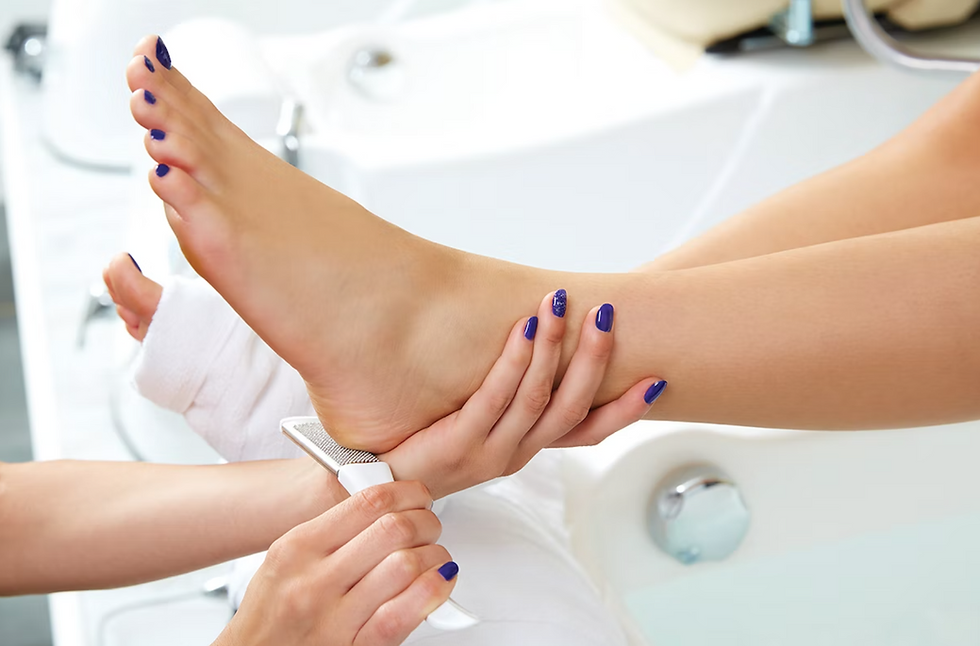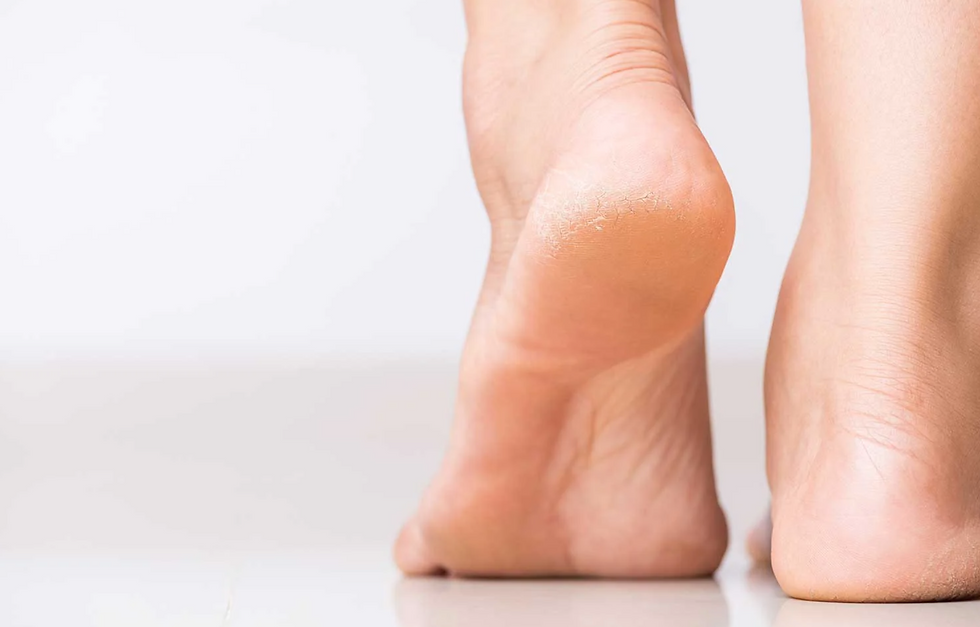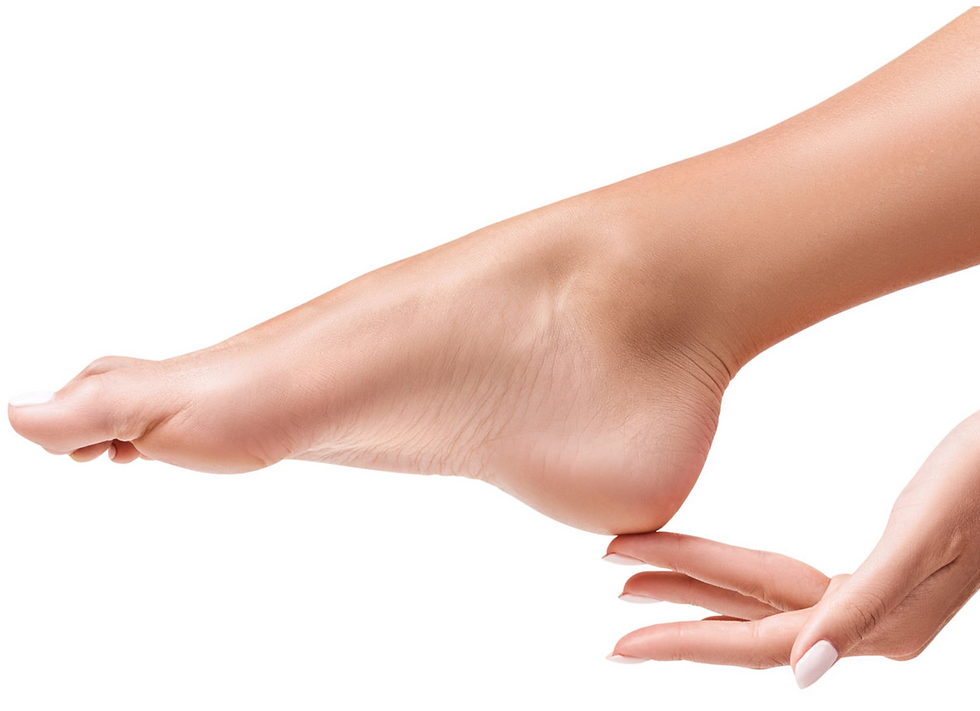Understanding Callus Treatment and Removal
- The Shampoo Lounge

- Feb 23, 2023
- 5 min read

A callus is a thickening condition of the skin often caused by repeated friction, excessive pressure on a specific area, or prolonged contact with a hard surface from common activities such as walking or running. Athletes are more prone to getting plantar calluses that form at the bottom of the feet.
Why Do Calluses Form?
Foot calluses can form from a variety of reasons – the natural bone shape and structure, or from an injury due to the excessive friction between the skin and bones. As the skin thickens, it forms a protective tissue layer that hardens. Plantar calluses develop along the band of connective tissue between your heel bones to your toes and the balls of feet, otherwise known as the plantar fascia. The body’s natural protective process creates a layer to absorb impact and distribute pressure around the sensitive areas to prevent further damage. Although plantar calluses can cause discomfort, it is a common condition that is very treatable.
If a callus is left untreated, it can lead to further complications such as ulcers and bone infections. Having a number of calluses on the feet may be an indication of poor blood circulation that may be a result of not wearing proper-fitted shoes or socks.

Calluses and People with Diabetes
People with diabetes are especially prone to getting calluses and may have multiple calluses concurrently that can result in nerve damage. In someone with diabetes or other neurological conditions, this condition is considered pre-ulcerative, i.e. without treatment ulcers are likely to form [1].
For people with diabetes or low blood circulation to the feet, without callus treatment open sores or ulcers can develop and increase the risk of further health complications if not addressed properly. Other foot conditions that can increase your risk of calluses include bunions, hammertoes, or bone spurs.

Foot Calluses in Runners
Improper postural alignment limits the function of the body. To correctly overcome postural misalignments, an effective callus treatment plan should focus on biomechanics. The body can be voluntarily controlled to a significant extent simply by adjusting postural alignment to reduce muscle tension and restore fluid range of motion. Now you may ask, how does alignment of the spine affect calluses?
Calluses are one of the body’s ways to tell us that there is an imbalance somewhere that’s creating additional stress on your feet. Runners can develop calluses in different areas as the layer of hardened tissue forms at the bottom of the feet from repetitive impact against hard surfaces or shoes against the back of the feet.
The gait cycle is extraordinary unique to each person, so the treatment recommendation to relieve calluses differs slightly from patient to patient. However, this foot condition can provide specific clues to range of movement issues in the lower extremities that can help our podiatrists correct diagnose postural misalignments due to an unnatural gait.
Calluses are a result of friction, and if your running gait is truly balanced, there should be minimal friction between your feet and shoes. A recurring callus may point to discrepancies in your form that causes your foot adjustments either slightly backwards or pivot lightly when you’re bearing weight.
When a foot callus forms on the side of a big toe, it’s typically from an imbalance in running form such as overpronation where the foot’s arches roll inward and you push off with the big toe. If you feel like your foot and calf are working harder, it might be related to a stiff torso that’s creating a downward and backward force during ‘toe-off’.
Adjustments in running form or footwear may be needed if you frequently develop calluses. Make sure the width of your shoes are wide enough to prevent pinching. Shoes that provide more support, yet remain comfortably snug, can help stabilize feet from rolling inward. You can also wear a good pair of running socks that are moisture-wicking to help reduce friction that causes calluses.
Calluses typically don’t cause pain, so if the callus hurts, a blister may have developed underneath or it could be a corn or wart instead. Regardless of the condition, seeing a podiatrist is always helpful to alleviate any doubt.
To prevent calluses as a runner, The Foot Practice’s podiatrists can recommend properly-fitting footwear or arrange for a 3D Gait Analysis to identify the running gait issues that may be the root cause of your callus.

Calluses and Women’s High-Heeled Shoes
Just as postural misalignments cause calluses in runners, wearing high heels can also shift body weight to create this uncomfortable foot condition. Wearing high-heeled shoes often decreases the angle of the when we bend forward as your natural equilibrium is altered and the body has to compensate for the change in center of height. Muscles that run virtually the entire length of the spine have to work harder to balance the extra force compressing the lower spine, which leads to fatigue and back pain. In addition, as women age, the fatty tissue under the balls of the feet used to push off when walking or running moves back, and calluses are the body’s natural response to the increase in pressure. Wearing high heels exacerbates all of these issues. One solution The Foot Practice provides is orthoses to help with comfort and support specifically designed for women who wear high heels.
How Does A Podiatrist Treat or Remove A Callus?
A podiatrist treats calluses to prevent the condition from getting worse and leading to other more serious problems beyond issues walking or abnormalities of the foot. Callus removal is typically performed by scraping the outer surface with a scalpel or other medical instrument if they cause pain or interfere with movement patterns. Foot callus removal are best treated when they’re just starting to form, but treatment is not a cure-all solution. Calluses will return without proper care.
Early calluses treatment is the best prevention. Calluses are a common foot condition experienced by many. They can be caused by an injury or simply from too much pressure on the same area of skin over time.
The most common places for them to form are on the feet and palms due to their use in day-to-day life. Callus treatment is essential for people who are diabetic or have poor circulation in their feet. If you think you have a callus and experience pain, or if you require a Diabetic Foot Screening or Footwear Assessment advice, make an appointment with The Foot Practice’s podiatry team so that we can properly assess whether callus treatment Singapore is right for you.
Do you need callus treatment? We got you covered! The Shampoo Lounge will help you. The Shampoo Lounge has been attending to an international and Indonesian clientele since 2012 so check out our instagram, our website and our TripAdvisor reviews! We can’t wait to have you in.
➡️ BOOK NOW: https://www.shampoolounge.com/booking
Article written by Lead Podiatrist Tim Maiden from thefootpractice.com


Comments